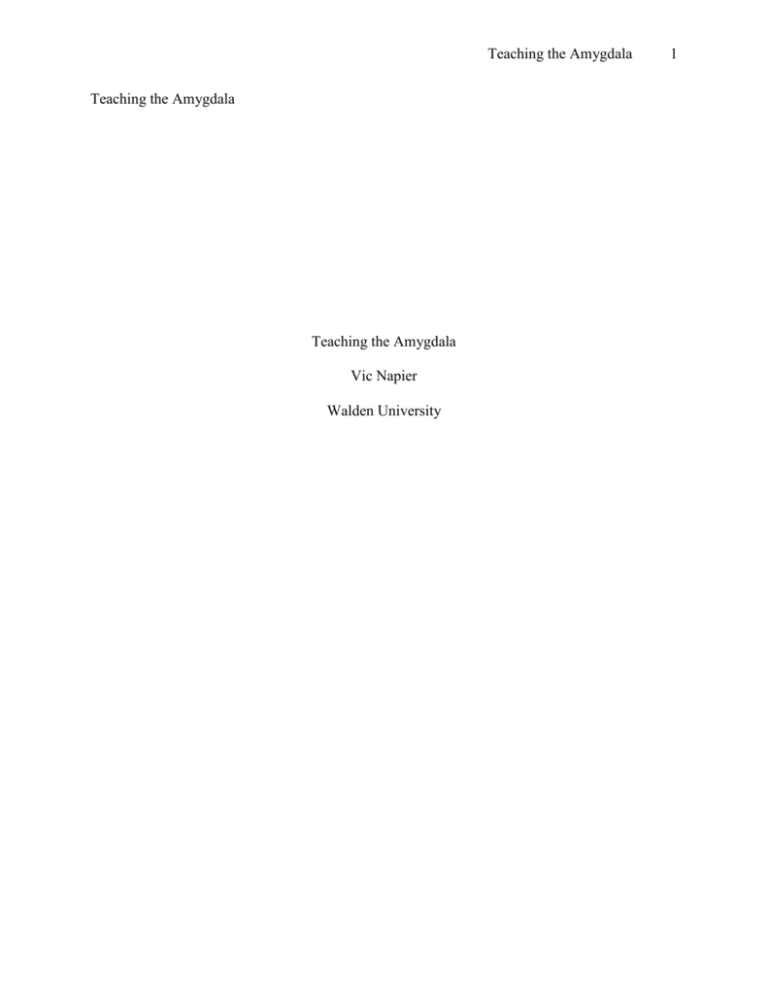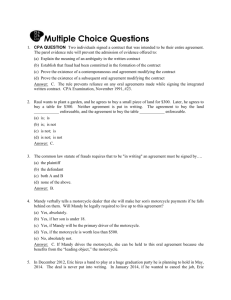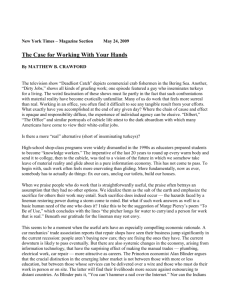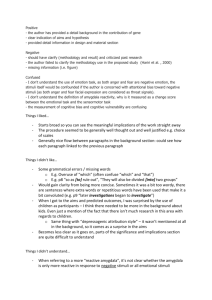American Psychological Association 5th Edition
advertisement

Teaching the Amygdala Teaching the Amygdala Teaching the Amygdala Vic Napier Walden University 1 Teaching the Amygdala 2 Abstract This paper focuses on the role of the amygdala in initiating fear responses and suggests a training regimen that could be effective in integrating motorcycle emergency procedures into amygdala initiated fear responses. A Proposed Plan Page 3 Teaching the Amygdala Gordon Graham, a former motorcycle police officer and currently a municipal risk management attorney points out that, "Any vehicle whose natural position at rest is on its side is not a safe vehicle". Nevertheless, millions of people operate motorcycles both as a primary means of transportation and recreational pastime. This paper will examine research relevant to teaching motorcyclists collision avoidance behaviors. According to the US Department of Transportation, about half of motorcycle fatalities result from single vehicle accidents; of these, about one third involved an attempt to avoid collision, and about one third did not. It was determined that in fully 30% of fatal single vehicle motorcycle accidents no avoidance maneuvers were attempted. (Shankar 2001). What could explain this high proportion of fatal outcomes in which operators made little or no attempt to avoid collision? Although some situations leave little time for evasive maneuvers, it does not seem logical that this alone would explain such a large portion of fatal one-vehicle collisions. More likely the explanation lies in the way the brain perceives danger, the response of the motor areas that initiate behavior, and how those behaviors influence the speed and course of the motorcycle. Cognition and the Fear Response The brain evaluates sensory data automatically, without conscious awareness or direction. The thalamus is the first to receive raw data from directly sensory organs. The thalamus makes initial refinements to the raw data, and passes it along to the sensory cortex and simultaneously to the amygdala. A Proposed Plan Page 4 The amygdala screens sensory data for emotional content. The amygdala is the structure that recognizes dangerous situations and initiates the fear response. Highly threatening objects -a car pulling in front of motorcyclist, for example – elicit a fear response from the amygdala, which bypasses the sensory cortex and higher cognitive functions and sends signals that initiate a motor response (Ratey 2001, LeDoux 2002, 1996). In other words, when the amygdala identifies a threat it sends signals through a “shortcut” directly to the motor cortex. Although the same signals continue to propagate through a more complex cognitive path, they move more quickly through the “shortcut”. (See Figure 1.) This is the fear response that occurs so quickly we sometimes do not realize what has happened until it is over. Figure 1. Illustration of fear response. From Ledoux (2002), p. 123 A Proposed Plan Page 5 During this time visual attention shifts from object to object classifying each one in terms of most serious threat. The object that seems be the most threatening is focused upon, to the exclusion of everything else. The field of vision actually narrows until the only thing in the visual field is the threat object (Rogers, Alderman, & Landers, 2003; Staal 2004). Motorcyclists might have a safe path around a car or tree but their field of vision is so narrow that they may never see it. This might explain the high proportion of fatal single vehicle motorcycle accidents. Possibly these motorcyclists avoid an initial collision with another vehicle only to impact a stationary object they never saw near the roadway Deliberate behaviors vs. panic reactions These automatic actions are not under conscious control; the resulting behaviors are the product of neurons in the motor cortex initiating previously learned behaviors. For example, the behavioral result of seeing a snake in our path may be an automatic and uncoordinated jump or lurch away from the creature. When confronted with a dangerous situation while driving an automobile our behavioral reaction is to slam on the brake pedal with our right foot. These behaviors are not under the control of higher brain functions and can be described as “panicked” rather than “deliberate”. Traditional motorcycle training is not sufficient to ensure a significant decrease in motorcycle fatalities associated with collisions. The fear response initiated by the amygdala needs to modified to include behaviors that result in deceleration and directional change of the motorcycle. Although this sounds like a reasonable task, the behavioral mechanics of collision avoidance is not as simple for motorcyclists as it is for drivers of automobiles. Cognitive Challenges of Motorcycle Operation A Proposed Plan Page 6 Swerving and braking a motorcycle under emergency conditions is a cognitively complex task. Under conditions of extreme stress, the brain must interpret sensory and somatic information, analyze it terms of messages relevant to the operation of a motorcycle, decide on a course of action and transmit commands to the motor cortex. The motor cortex must contain a series of instructions for collision avoidance that are held as a single “chunked” memory that can be transmitted to the muscles that operate the motorcycle. (This is incorrectly labeled “muscle memory”; the memories are actually held in low-level storage in the motor cortex.) However, the memories stored in the motor cortex must be very complex, reflecting the complex nature of motorcycle operation. The dynamics of braking constantly change due to friction, aerodynamics and physics; even under normal conditions motorcycle operators adjust brake pressure on both front and rear wheels to maintain control and stability (Limebeer, Sharp & Evangelou 2001). For example, motorcycles have independent front and rear brake systems. The front brake provides about 80% of stopping power; as the vehicle slows, weight transfers to the front tire from the rear, giving the front tire more traction and the rear tire less. As the motorcycle decelerates the rear tire becomes more likely to lose traction and initiate an uncontrollable skid unless the operator reduces brake pressure on the rear wheel. Another significant factor in emergency braking is that it is not a linear process. The first three fourths of stopping distance is used to lose half the initial speed, while the remaining half is lost during the final quarter of the original distance. All other factors remaining equal, the most deceleration occurs in the last quarter of the distance to impact. This counter intuitive process is associated with a common cause of loss of control by motorcyclists. In the last half of an emergency braking procedure, it appears that the distance to impact is not decreasing rapidly A Proposed Plan Page 7 enough and riders often apply too much brake to the rear wheel causing a skid, lose yaw control and crash (Ouellet & Kasantikul 2006). Is it possible to re-train the fear response to include behaviors at the level of sophistication needed for collision avoidance? Surprisingly there is no clear evidence that traditional training courses results in fewer accidents. Billheimer (1998) found that motorcycle training courses reduced fatalities only minimally for six months after training and had no effect on motorcyclists who had more than 500 miles of experience before taking the course. In a study of Indiana motorcyclists Savolainen and Mannering (2007) found an increase in fatalities among those who had taken a motorcycle safety course. The reasons for this are unclear, although the authors speculate that course participants selected themselves for instruction because they knew their habits or skills put them at risk. A Thai study (Swaddiwudhipong, Boonmak, Nguntra, & Mahasakpan, P. 1998) found that motorcycle safety courses correlated positively with helmet use and negatively with motorcycle related injuries; however there was no reduction in motorcycle related fatalities. Data collected in Los Angeles in 1995 found that police motorcycle officers who receive extensive training and accrue tremendous experience were no more likely to take evasive maneuvers or apply the front brake than civilian riders without formal training (Ouellet & Kasantikul 2006). Overestimating skills, underestimating risks Traditional training courses typically spend more time on massed practice of braking and swerving, and fail to develop “chunked” motor skills, or the sophisticated training that might retrain the amygdala to initiate them. A Proposed Plan Page 8 In a study of motor learning and keystroke behavior, Simon and Bjork (2001) found that subjects overestimated their accuracy after massed practice. Subjects did not appreciate how quickly performance decreased with time in the absence of distributed practice. In a study of the low efficacy of driving courses addressing operating motor vehicles on snow and ice in Nordic countries, Katila, Keskinen, and Hatakka, (1996) found that students missed the entire point of the classes. While instructors and curriculum designers sought to emphasize the importance of developing judgment and assessment skills, the students who took the classes rated maneuvering skills as more important. Not only might motorcyclists be over confidant, but they also seem to underestimate the danger of riding a motorcycle. In a survey of motorcyclists in the United Kingdom, Rutter, Quine, and Albery (1998) found that motorcyclists tended to under estimate their risk exposure. On average, the 723 respondents believed that they had a lower than average chance of experiencing a serious accident. Interestingly individuals who perceived themselves at higher risk were also the individuals who reported engaging in the most risky behaviors. In other words, their actions put them at greater risk and they knew it. For these motorcyclists the perception of risk did not diminish behaviors that put them at risk. This might be explained by the findings of Bell, Schoenrock, and O'Neal, (2000) who found a positive correlation between self monitoring and risky behaviors. That is, individuals who have put a high value on the impression they make on others also scored higher on sensation seeking scales. If these findings generalize to motorcyclists, attending a safety course might increase confidence far out of proportion to increasing riding skills, and does little to integrate the complex skills needed for collision avoidance into the fear response. This may explain the finding of Mannering (2007) who found an increase in fatalities among those who had taken a A Proposed Plan Page 9 motorcycle safety course. Attending traditional motorcycle training courses may actually decrease the safety of participants because the skills learned are not used on the street, evidenced by the low rate of collision avoidance attempts, yet confidence is so high that participants have an inflated perception of their own skills. It seems the solution to this problem is to integrate collision avoidance behaviors into amygdala initiated fear responses. How does the amygdala learn to initiate new behaviors, and what is the best way to teach those behaviors? Implicit Learning of Complex Behaviors There is no question that fear responses initiated by the amygdala can be taught, and that they can be executed appropriately in dangerous situations. In a metastudy of animal research using genetically engineered mice investigating neural circuits involved in fear conditioning Fanselow and Poulos (2005) identify an important finding. The studies they survey agree that emotional memory and motor response are under the control of independent neural circuits. This is important for collision avoidance training because it implies that motor memories do not have to linked with emotional memory during learning in order for them to be initiated by the fear response. In other words, the amygdala can call on skills learned in a training environment as part of a fear response. Human experiments using Functional Magnetic Resonance Imaging (fMRI) to detect amygdala activity also support this finding. Cheng, et al. (2006) subjected human volunteers to small electrical shocks under both random and predictable conditions while the amygdala was being observed using fMRI. Researchers found that as subjects learned to predict the electrical shocks the amygdala became more active. They were able to see the amygdala learn when a shock was coming, A Proposed Plan Page 10 Subjective observation of automobile operation and recreational sports supports the conclusion that the amygdala is involved in learned emergency procedures. Applying brakes and steering around obstacles to avoid collisions is common in automobiles, for example. Skydivers receive training prior to their initial jumps to pull two handles in sequence to release a malfunctioning main parachute and open the reserve parachute. The aviation industry has demonstrated that behaviors more complex than automobile braking and steering can be learned and applied in the proper situations. These behaviors may not be as complex as those involved in motorcycle collision avoidance, but they almost certainly involve modification of the fear response by the amygdala and motor cortex. However, the previous discussion regarding poor efficacy of motorcycle training illustrates that it is unclear whether normal training courses can teach the complex collision avoidance behaviors required by motorcyclists. Cognitive mechanics of teaching new fear responses Exactly how new behaviors are integrated into the threat response of the limbic system is unknown, but it seems that the amygdala stores long term memories of fear conditioning (Medina, Christopher, Repa, Mauk, & LeDoux, 2002). In a study of role of the amygdala and hippocampus Strange and Dolan (2006) speculate that these structures may mediate sensory inputs with cortical function to encode unexpected stimuli. These researchers speculate that the amygdala may trigger a specific set of implicit behaviors stored in the lower levels of the sensorimotor system residing in the motor cortex. A Proposed Plan Page 11 If this is the case, it is possible that highly sophisticated and complex behaviors, such as those needed to avoid imminent collisions while riding a motorcycle, could be learned and implemented in a smooth and coordinated manner. Deliberative Rather Than Panicked Action Collision avoidance maneuvers must be deliberative behaviors rather than panic based reactions. The fear response to an impending collision must be more than suddenly applying maximum rear brake. Instead, a sophisticated application of a complex set of behaviors that respond to sensory inputs must be executed. That is to say, even though the motorcycle may be operated to its performance limits, and the operator may be reaching the limits of coordination and control, behaviors must be coordinated, smooth and automatic. These behaviors must be implicit, in the sense that they require no conscious thinking or initiation. When the amygdala receives sensory information it interprets as danger and initiates a fear response the motor cortex must engage a low-level series of instructions to muscles that result in coordinated control inputs to the motorcycle. In other words, the challenge is to train the amygdala to initiate a well-practiced routine stored in the motor cortex that will result in collision avoidance. Lessons from skiing research Avoiding obstacles while skiing may be the closest approximation to the challenge of avoiding collisions on a motorcycle. In both cases, the brain processes a vast amount of sensory and somatic information prior and during fear response. Balance, speed, angles, and pitch and yaw of the body/motorcycle unit all figure in calculations needed to avoid collision in both motorcycling and skiing. A Proposed Plan Page 12 In one of the few longitudinal studies of motor learning Nourrit, Delignieres, Caillou, Deschamps, and Lauriot, (2003) examined how skiers progressed from novice to expert. These researchers designed a training regimen in which their subjects practiced slalom skiing skills on a mechanical simulator three times a week for thirteen weeks. The speed and duration of lateral foot movement – that similar to the oscillations made by the feet while slalom skiing – were measured for frequency and smoothness. This was a challenge to the motor cortex of balance, coordination and rhythm of a complexity that approaches that of the operation of motorcycles. The learning modality – three times a week for thirteen weeks -- is an example of disturbed practice in which skills are repeated in discrete blocks over a long length of time, as opposed to massed practice in which skills are repeated continuously for a very short period. Massed practice is much like “cramming” for an exam, while distributed practice is similar to more traditional learning practices. The investigators found that complex learning is discontinuous. That is, complex motor behaviors are not simply more refined versions of basic skills, but qualitatively different at the novice and expert stages. Learning these complex skills progresses along an uneven path. Rather than steadily increasing skills, subjects would reach plateaus when performance would stagnate and after a time begin to progress again. The authors suggest that this is the result of behaviors being cognitively re-organized rather than simply learned or refined. The found evidence that in early stages of the acquisition of complex skills the neurological mechanics of learning is much different than in the later stages, and that practice leads to a replacement of the initial pattern of learning with a completely different one. This research seems to indicate that the brain needs time to master complex motor skills. Traditional motorcycle training that typically spans one or A Proposed Plan Page 13 two days and then ends does not seem to be adequate to train the complex motor skills needed to avoid collisions. Implications for Motorcycle Rider Training There are several implications for collision avoidance training. First, training is best spread over long periods to allow the brain to transition from the early learning style to the more mature one. This may not require the use of prepared tracks or other facilities, however. Earlier it was noted that automobile drivers and skydivers both use relatively simple emergency procedures -- drivers put their right foot on the brake pedal, and skydivers pull two handles in sequence. Every time a driver applies the brake, even in non-emergencies the motor cortex receives practice in the behavior. During the airplane ride to jumping altitude, skydivers frequently look at their handles and touch them in the proper sequence. In this way both groups practice these behaviors very frequently. Again, the motor cortex is reinforcing memories of “chunked” behaviors. Motorcycle training can use the same techniques. Formal training sessions should be separated by weeks or months, riders should be encouraged to practice emergency stopping and swerving when conditions allow on the street, and to use both front and rear brakes all the time. Simply applying both brakes on a routine basis will create a chunked braking behavior in the motor cortex that will be used when the amygdala initiates a fear response. Using both brakes while turning will also facilitate the learning of an emergency swerve. The common habit of motorcyclists to use only the rear brake while turning teaches exactly that to the motor cortex. During a fear response in reaction to a traffic emergency the motorcyclist will likely use only the rear brake if an turn is initiated to avoid a collision, likely resulting in a A Proposed Plan Page 14 skid, loss of control and crash. Routinely using both brakes while turning teaches the motor cortex that skill, and it will be available in an emergency. The design of training regimens needs to draw a distinction between higher cognitive functions and motor learning. Most of what is discussed in the course needs to target situational awareness, predicting the behavior of other drivers and survival strategies. There should be very little discussion of collision avoidance behaviors; instead, time that would have been spent on the cognitive aspect of collision avoidance should be spent on training the motor cortex in new skills. Finally rider courses should not claim that motorcycling can be safe, or that riders who take such courses are any safer than those who do not. Aside from the ethical implications of misleading participants as to the efficacy of training courses, these claims tend to encourage risktaking behavior. Instead, training courses should emphasize that motorcyclists are extremely vulnerable while on the street and that they are frequently at the mercy of the skills of other drivers with whom they share the road. A Proposed Plan Page 15 References Bell, N. J., Schoenrock, C. J., & O'Neal, K. K. (2000). Self-monitoring and the propensity for risk. European Journal of Personality, 14(2), 107-119. Billheimer, J. W. (1998). Evaluation of California motorcyclist safety program. Transportation Research Record: Journal of the Transportation Research Board 1998(1640 ), 9. Cheng, D. T., Knight, D. C., Smith, C. N., & Helmstetter, F. J. (2006). Human Amygdala Activity During the Expression of Fear Responses. Behavioral Neuroscience, 120(6), 1187-1195. Fanselow, M. S., & Poulos, A. M. (2005). The neuroscience of mammalian associative learning. Annual Review of Psychology, 56(1), 207-234. Katila, A., Keskinen, E., & Hatakka, M. (1996). Conflicting goals of skid training. Accident Analysis & Prevention, 28(6), 785-789. LeDoux, J. E. (1996). The emotional brain : the mysterious underpinnings of emotional life. New York: Simon & Schuster. LeDoux, J. E. (2002). Synaptic self : how our brains become who we are. New York: Viking. Levine Reed L. and Bernard S. Gorman (1994). “Skiers' Perceptions of Danger as a Function of Awareness of Fatalities.” Journal of Sport Behavior, Volume 17, Number 1, (March)17 Limebeer, D. J. N., Sharp, R. S., & Evangelou, S. (2001). The stability of motorcycles under acceleration and braking. Proceedings of the Institution of Mechanical Engineers -- Part C -- Journal of Mechanical Engineering Science, 215(9), 1095-1109. A Proposed Plan Page 16 Medina, J. F., Christopher Repa, J., Mauk, M. D., & LeDoux, J. E. (2002). Parallels between cerebellum- and amygdala-dependent conditioning. Nature Reviews Neuroscience, 3(2), 122-131. Nourrit, D., Delignieres, D., Caillou, N., Deschamps, T., & Lauriot, B. (2003). On Discontinuities in Motor Learning: A Longitudinal Study of Complex Skill Acquisition on a Ski-Simulator. Journal of Motor Behavior, 35(2), 151. Ouellet, J. V., & Kasantikul, V. (2006). Rider Training and Collision Avoidance in Thailand and Los Angeles Motorcycle Crashes. Paper presented at the 2006 International Motorcycle Safety Conference. Reynolds, D. (6-16-2008). PRIMA Report: Long Live Gordie. Risk and Insurance Online. Availabe at: http://www.riskandinsurance.com/story.jsp?storyId=102161967&query=motorcycle Rogers, T. J., Alderman, B. L., & Landers, D. M. (2003). Effects of life-event stress and hardiness on peripheral vision in a real-life stress situation. Behavioral Medicine, 29(1), 21-26. Rosenbloom, T. (2003). Risk evaluation and risky behavior or high and low sensation seekers. Social Behavior & Personality: An International Journal, 31(4), 375. Rutter, D. R., Quine, L., & Albery, I. P. (1998). Perceptions of risk in motorcyclists: Unrealistic optimism, relative realism and predictions of behaviour. British Journal of Psychology, 89(4), 681. Savolainen, P., & Mannering, F. (2007). Effectiveness of motorcycle training and motorcyclists' risk-taking behavior. Journal Transportation Research Record: Journal of the Transportation Research Board 2007(2031), 6. A Proposed Plan Page 17 Shankar, U. (2001). Fatal single vehicle motorcycle crashes. Retrieved. from http://www.webbikeworld.com/Motorcycle-Safety/809-360.pdf. Sharp, R. S. (2001). Stability, control and steering responses of motorcycles. Vehicle System Dynamics, 35(4/5), 291-318. Simon, D. A., & Bjork, R. A. (2001). Metacognition in motor learning. Journal of Experimental Psychology / Learning, Memory & Cognition, 27(4), 907. Staal, M. (2004). Stress, cognition, and human performance: A literature review and conceptual framework. Retrieved. from http://humanfactors.arc.nasa.gov/web/library/publications/publications.php. Strange, B. A., & Dolan, R. J. (2006). Anterior medial temporal lobe in human cognition: Memory for fear and the unexpected. Cognitive Neuropsychiatry, 11(3), 198-218. Swaddiwudhipong, W., Boonmak, C., Nguntra, P., & Mahasakpan, P. (1998). Effect of motorcycle rider education on changes in risk behaviours and motorcycle-related injuries in rural Thailand. Tropical Medicine & International Health, 3(10), 767-770. Thompson, L. A., Williams, K. L., L'Esperance, P., & Cornelius, J. (2001). Context-dependent memory under stressful conditions: The case of skydiving. Human Factors, 43(4), 611619.







